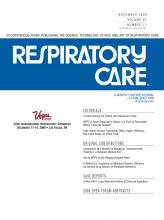Abstract
BACKGROUND: A substantial percentage of the aerosol produced by a nebulizer is lost down the expiratory limb of the ventilator circuit. We describe a method for the capture, return, and reaerosolization of that undelivered aerosol.
METHODS: We designed an expiratory-limb setup in which an “entraining jet” of gas accelerates unused aerosol and propels it toward an impaction surface. The deposited solution is then returned to the nebulizer reservoir via a feedback tube. As a result, more of the initial dose is delivered to the patient. The fraction of the dose delivered to a filter connected to a passive neonatal test lung was measured with and without the aerosol-recycling components activated. We used a ΔP (difference between the peak inspiratory pressure and the positive-end-expiratory pressure) of approximately 7.5 cm H2O, tidal volume of approximately 6 mL, respiratory rate of 40 breaths/min, and an inspiratory-expiratory ratio of 1:2.3.
RESULTS: There was a statistically significant improvement with the feedback return to the reservoir, with up to nearly 60% more aerosol delivered.
CONCLUSION: This improvement in aerosol delivery is encouraging, but more comprehensive studies are needed before such a device could be implemented clinically.
Footnotes
- Correspondence: Michael C Quong, Electrical and Computer Engineering Research Facility, University of Alberta, 9107 116 Street, Edmonton, Alberta T6G2V4 Canada. E-mail: mquong{at}ualberta.ca.
Michael C Quong and Warren H Finlay PhD PEng received financial support from the Natural Sciences and Engineering Research Council of Canada. Bernard Thébaud PhD MD received financial support from the Alberta Heritage Foundation for Medical Research and the Canadian Institutes of Health Research.
The authors report no conflicts of interest related to the content of this paper.
- Copyright © 2006 by Daedalus Enterprises Inc.











